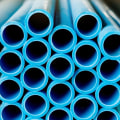PVC pipes are an excellent choice for plumbing projects that require high water pressure. They are incredibly durable and can last indefinitely, provided they are not subject to any damage. PVC piping is also rust and corrosion-resistant, and its smooth inner coating prevents sediment accumulation and blockages. Cross-linked polyethylene tubing, also known as PEX, is another popular option for hot and cold water supply lines.
It is flexible enough to weave through walls, ceilings, and tight spaces, while still being rigid enough to withstand the pressures of the water supply. PEX is an affordable plastic plumbing solution that is easy to install and resistant to freezing or blockages. Copper pipes are also a great choice for high pressure lines, as they can withstand hot and cold water temperatures and protect against rust and corrosion. When it comes to plumbing projects, it's always best to leave it to the professionals.
Licensed plumbers have the experience and knowledge necessary to perform specific plumbing tasks, such as changing pipes and modernizing them. However, it's still important to stay informed about the different types of pipes available so you can make an educated decision when it comes time to do some DIY plumbing tasks around the house or advise someone else about it. The most common types of plumbing pipes used in homes are PVC, PEX, ABS, copper, or galvanized steel pipes. Each type has its own advantages and disadvantages, so it's important to consider your needs before making a decision.
For instance, PVC pipes are great for sink drains and ventilation grilles due to their small size, while copper pipes are ideal for high pressure lines due to their ability to withstand hot and cold water temperatures. PEX tubing is a great all-around option that is reasonably economical, easy to use, multifunctional, and durable. When replacing old pipes in your home or making significant improvements to an older system, it's best to completely replace them with PVC, PEX, copper or ABS pipes. These materials have been proven to be more reliable than their predecessors such as clay and straw in ancient Greece or cast iron.
In some states, PVC pipes have even been banned from carrying drinking water due to their potential health risks. This article was designed to give you an understanding of the different types of plumbing materials available so you can make an informed decision when it comes time for your next plumbing project. Whether you're a homeowner or a professional plumber, understanding the different types of materials will be beneficial in the long run.




Leave a Comment